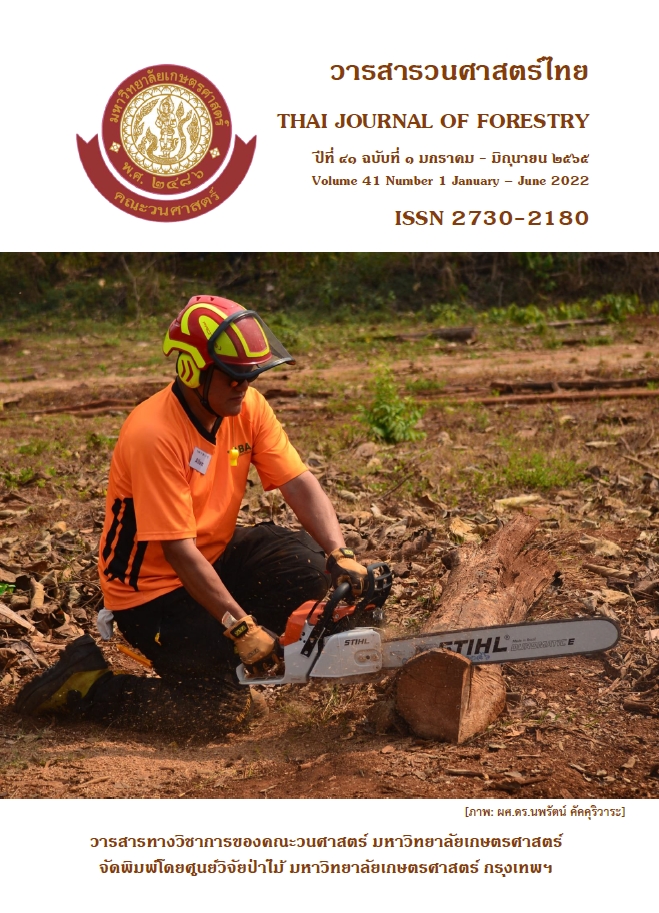การเปรียบเทียบปริมาตรไม้ในการผลิตเตียงไม้สักระหว่างโรงงานเวียงทองค้าไม้ และโรงงานมีของค้าไม้ อำเภอสูงเม่น จังหวัดแพร่
Main Article Content
บทคัดย่อ
งานวิจัยการศึกษาการเปรียบเทียบปริมาณการใช้ไม้ในการผลิตเฟอร์นิเจอร์ไม้สักของโรงงานเวียงทองค้าไม้กับโรงงานมีของค้าไม้ อำเภอสูงเม่น จังหวัดแพร่ มีวัตถุประสงค์เพื่อเปรียบเทียบปริมาณการใช้ไม้ ปริมาณการสูญเสียในการผลิตเฟอร์นิเจอร์ไม้สัก และราคาของผลิตภัณฑ์เฟอร์นิเจอร์ของทั้ง 2 โรงงาน โดยการเก็บข้อมูลทั่วไป ข้อมูลการผลิต และข้อมูลราคาจากการผลิตภัณฑ์เฟอร์นิเจอร์ทั้ง 10 ประเภท ได้แก่ เตียงเต้า เตียงซี่โค้งพระจันทร์ เตียงเอสเจ็ด เตียงซี่เต้ากลาง เตียงใบบัว เตียงกล่อง เตียงซี่แบน เตียงโมเดิร์น เตียงใบพัด และเตียงหัวบัง จำนวนประเภทละ 3 ซ้ำ พบว่า โรงงานเวียงทองค้าไม้ ส่วนใหญ่มีบุคลากรที่มีระยะเวลาในการทำงาน 6-10 ปี ร้อยละ 75.00 มากกว่าโรงงานมีของค้าไม้เฉลี่ยร้อยละ 35.00 และโรงงานมีของค้าไม้ ส่วนใหญ่มีบุคลากรเป็นเพศชายร้อยละ 80.00 มีอายุ 30-39 ปีร้อยละ 80.00 มีระดับการศึกษาในระดับประถมศึกษาร้อยละ 80.00 มีอาชีพลูกจ้างร้อยละ 80.00 มีรายได้ต่อเดือน 10,000-20,000 บาท ร้อยละ 80.00 มากกว่าโรงงานมีของค้าไม้เฉลี่ยร้อยละ 5.00 ส่วนการศึกษาด้านการผลิต พบว่า โรงงานเวียงทองค้าไม้ มีร้อยละปริมาณการสูญเสียจากการใช้ไม้เฉลี่ยร้อยละ 18.96 ซึ่งมากกว่าโรงงานมีของค้าไม้เฉลี่ยร้อยละ 5.88 ส่วนโรงงานมีของค้าไม้มีร้อยละปริมาณการใช้ไม้ในการผลิตร้อยละ 86.92 ซึ่งมีจำนวนมากกว่าโรงงานเวียงทองค้าไม้เฉลี่ยร้อยละ 5.88 ส่วนการศึกษาด้านราคา พบว่า โรงงานเวียงทองค้าไม้ มีกำไรร้อยละ 18.96 ซึ่งมีจำนวนมากกว่าโรงงานมีของค้าไม้เฉลี่ยร้อยละ 3.12
Downloads
Article Details

อนุญาตภายใต้เงื่อนไข Creative Commons Attribution-NonCommercial-NoDerivatives 4.0 International License.
ข้าพเจ้าและผู้เขียนร่วม (ถ้ามี) ขอรับรองว่า ต้นฉบับที่เสนอมานี้ยังไม่เคยได้รับการตีพิมพ์และไม่ได้อยู่ในระหว่างกระบวนการพิจารณาตีพิมพ์ลงในวารสารหรือสิ่งตีพิมพ์อื่นใด ข้าพเจ้าและผู้เขียนร่วม (ถ้ามี) ยอมรับหลักเกณฑ์และเงื่อนไขการพิจารณาต้นฉบับ ทั้งยินยอมให้กองบรรณาธิการมีสิทธิ์พิจารณาและตรวจแก้ต้นฉบับได้ตามที่เห็นสมควร พร้อมนี้ขอมอบลิขสิทธิ์ผลงานที่ได้รับการตีพิมพ์ให้แก่วารสารวนศาสตร์ คณะวนศาสตร์ มหาวิทยาลัยเกษตรศาสตร์ กรณีมีการฟ้องร้องเรื่องการละเมิดลิขสิทธิ์เกี่ยวกับภาพ กราฟ ข้อความส่วนใดส่วนหนึ่ง หรือ ข้อคิดเห็นที่ปรากฏในผลงาน ให้เป็นความรับผิดชอบของข้าพเจ้าและผู้เขียนร่วม (ถ้ามี) แต่เพียงฝ่ายเดียว และหากข้าพเจ้าและผู้เขียนร่วม (ถ้ามี) ประสงค์ถอนบทความในระหว่างกระบวนการพิจารณาของทางวารสาร ข้าพเจ้าและผู้เขียนร่วม (ถ้ามี) ยินดีรับผิดชอบค่าใช้จ่ายทั้งหมดที่เกิดขึ้นในกระบวนการพิจารณาบทความนั้น”
เอกสารอ้างอิง
Asanok, L., Kiratikarnkul, S., Yotapakdee, T., Howpinjai, I., Sukjareon, S., Wanishdilokratn, T., Wirojanarome, W., Kamton, R. 2020. Research Report of Advance in Value Chain of Entrepreneurs’ Teak Furniture Industry in Phrae Province. Thailand Science Research and Innovation (TSRI). (in Thai)
Buranupakorn, T. 2001. Cost-Benefit Analysis of Teak Furniture Company in Muang District, Chiang Mai Province. M. Econ. thesis, Faculty of Economics, Chiang Mai University. Chiang Mai, Thailand. (in Thai)
Community Enterprise Office. 2021. Ban Pong Sub District, Sung Men District, Phrae Province. Ban Pong Sub District Administrative Organization Office, Phrae. (in Thai)
Kosakul, T., Chantarasanit, A., 2001. Forest: Our Resources, Our Culture. Faculty of Science, Chulalongkorn University. (in Thai)
Immaculate, M., Selma, L., Margaret, A., Jesaya, N. 2016. Forest resource management and utilisation through a gendered lens in Namibia. Environment and Natural Resources Research 6(4): 79-90.
Maichan, A. 2017. The Factors Affecting Performance Efficiency among Employees in Machine Installed Production Line, Songkhla Province. M.B.A. thesis, Faculty of Management Sciences, Prince of Songkla University. Songkla, Thailand. (in Thai)
Pankhaw, O., Suksard, S. 2014. Production and marketing of Teak products at Namcham sub-district, Sung Men district, Phrae province. Thai Journal of Forestry 33(1): 28-35. (in Thai)
Pete, B., Kevin, B., Jacek, S., Donald, G. 2016. Forest Management and Planning. Academic Press, Elsevier.
Phrae Provincial Office. 2022. Briefing of Phrae Province in 2022. Phrae Provincial Office, Strategic and Information Group for Provincial Development. (in Thai)
Ragnar, J. 2009. Forest Products Markets. External Drivers Affecting Swedish Forests and Forestry. Future Forests Working Report.
Robson, B.L., Rinaldo, L.F., José A.S., Marcelino, C.G., Cinthia, P.O., Diego A.S., Renan, M.S., Erik, P.F.C., Robson, M.S. 2019. Lumber volume modeling of Amazon Brazilian species. Journal of Sustainable Forestry 38(3): 262-274. doi: 10.1080/10549811.2018.1546596.
Roxy, P., Chris, O., Jay, D. 2008. Introduction to Statistics and Data Analysis. Thomson, Brooks Cole.
Royal Forest Department. 2020. Statistical Data of the Royal Forest Department 2020. Royal Forest Department, Bangkok. (in Thai)
Sandro, S., Costanza, B., Roberto, F. Iacopo, B. 2021. Assessment and valorization of non-wood forest products in Europe: a quantitative literature review. Sustainability 13(3533): 1-16. doi: 10.3390/su13063533.
Shi, Y.A., Chrusciel, L.B. Zoulalian, A. 2007. Production of Charcoal from Different Wood Species. Récents Progrès en Génie des Procédés – Numéro 96 – 2007 ISBN 2-910239-70-5, Ed. SFGP, Paris, France. https://www.researchgate.net/, 28 March 2022.
Thammanu, S., Hanc, H., Marod, D., Zange, L., Junga, Y., Soe, K.T., Onpromd, S., Chungg, J.,2020. Non-timber forest product utilization under community forest management in northern Thailand. Forest Science and Technology 17(4): 1-15. doi: 10.1080/21580103.2020.1862712.
Wanishdilokratn, T., Sukjareon, S., Howpinjai, I. 2021. Quantity of lumber in Nam Cham sub-district, Sung Men district, Phrae province. Proceeding of 10th Thai Forest Ecological Research Network Conference. Phrae, Thailand, pp.387-395. (in Thai)


